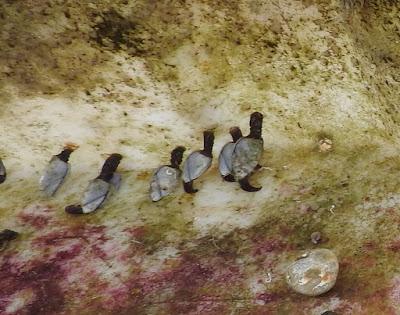Lade - cold, dry, SE 5 - A bitterly cold weekend of weather with a nasty wind made for uncomfortable birding conditions, while the clear blue sky of yesterday was replaced by cloud cover today making it feel even colder. Despite the overnight sub-zero temperatures most of the water on both lakes remained open due to the wind, apart from a few sheltered areas around the willow swamp and in front of the wall `mirror` where thin sheets of ice had formed, thick enough in places to support a few roosting birds.
Frozen images from around Lade
While there was little change to the duck numbers these past two days there appeared to be a few more Coots present than usual, which may have been birds forced off the continent where the temperatures are even lower than here. Whatever their origins they did not go un-noticed by the local Marsh Harriers with the larger females regularly patrolling groups of Coot along the reedbed margins seeking out weaklings; on one occasion I saw a harrier drop onto one that just managed to escape by diving underwater leaving the bedraggled raptor to emerge from the lake like an Osprey! Elsewhere across the site this weekend we had five sightings of Woodcocks which is inline with the current widespread influx of these serial fleers from a frozen northern Europe. All but one were of the disturbed-from-cover variety as they took flight and dropped down again well away and out of view; two from the ponds and two on the shingle ridges, but one late yesterday afternoon out in the open sat on a path. I had a ten second view of its cryptically camouflaged plumage just before a cat pounced flushing the bemused Woodcock into an adjacent back garden and out of sight! It seems incredible to me that such a fantastically mystical and beautiful bird should be a popular quarry species for the game shooting fraternity, and all for a sliver of breast meat and a pin-feather; indeed, many thousands are shot each winter here (many at specific Woodcock shoots in western Britain) and on the continent, so its little wonder that during my lifetime there has been a significant decline in their numbers. The Woodcocks` saving grace is that it continues to breed in good numbers across the vast, and largely undisturbed, taiga forest that straddles northern Eurasia, and long may it continue to do so.
GuillemotCurlew
Cuttlefish
Bag of garlic!
Goose Barnacles
This afternoon we braved the stiff south-easterly for a tideline search from the Lade boardwalk to the Pilot pub (about one mile). There was the usual array of dunnage, netting and plastics originating from passing ships and fishing boats, plus tree branches, pine cones and other vegetation washed down from rivers (probably the Rother). Countless dead sea creatures such as cuttlefish, crabs, cockles, whelks, slipper limpets and the like were everywhere amongst swathes of bladder wrack seaweed and two fish boxes covered in goose barnacles. More macabre were 11 Woodcock corpses along with four Guillemots, four Common Gulls, a Curlew and a small wader, probably a Sanderling. On the walk back I couldn`t help but reflect that what I found was most likely a tiny proportion of the birds that had died in this recent cold snap from exhaustion and starvation; how many more were claimed by the sea we shall never know...















No comments:
Post a Comment